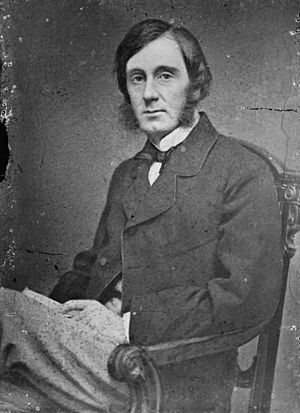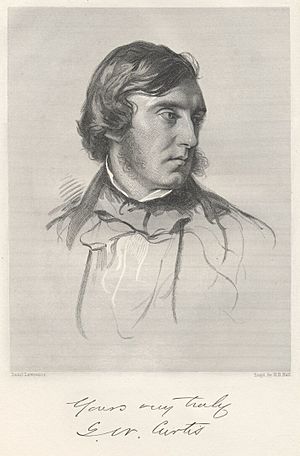George William Curtis facts for kids
Quick facts for kids
George William Curtis
|
|
|---|---|

Curtis between 1855 and 1865
|
|
| Born | February 24, 1824 Providence, Rhode Island, U.S.
|
| Died | August 31, 1892 (aged 68) New York City, New York, U.S.
|
| Nationality | American |
| Occupation | Writer, editor |
| Political party | Republican |
| Signature | |
George William Curtis (born February 24, 1824 – died August 31, 1892) was an American writer and public speaker. He was born in Providence, Rhode Island. As an early member of the Republican Party, he strongly supported equal rights for African Americans. He spoke out for these rights both before and after the Civil War.
Early Life and Learning
George William Curtis was born in Providence on February 24, 1824. His parents were George and Mary Elizabeth Curtis. Sadly, his mother passed away when he was only two years old. His grandfather, James Burrill Jr., was a important person who served in the United States Senate for Rhode Island.
When he was six, George and his older brother went to school in Jamaica Plain, Massachusetts. They stayed there for five years. Later, their father remarried, and the boys returned home to Providence. Around 1839, their father moved the family to New York.
Three years later, Curtis became interested in a way of thinking called Transcendentalism. This movement focused on finding truth through nature and personal experience. He joined a special community called Brook Farm from 1842 to 1843. His brother, James Burrill Curtis, was with him and helped him a lot. At Brook Farm, he met many interesting people. After two years there, he spent time in New York and Concord, Massachusetts. He wanted to be near the famous writer Ralph Waldo Emerson. Then, he spent four years traveling in Europe, Egypt, and Syria.
In 1856, he married Anna Shaw Curtis. George Curtis was a founding member of the Unitarian Church of Staten Island. He was also a writer and editor for Putnam's Magazine. He wrote columns for Harper's Weekly.
Curtis was a strong supporter of many important causes. He was an abolitionist, meaning he worked to end slavery. He also supported civil rights for African Americans and Native Americans. He believed in women's suffrage, which meant women should have the right to vote. He also pushed for civil service reform (making government jobs based on skill, not connections) and public education for everyone.
The Curtis and Shaw families were very connected to important thinkers like Emerson, Nathaniel Hawthorne, and Henry David Thoreau.
During the 1850s, the Underground Railroad was used to help runaway slaves escape to freedom. It is thought that the Curtises and Shaws were very involved in helping with the Underground Railroad. Anna and her sisters also helped during the Civil War. George Curtis was a target for people who supported the South. Because of this, Anna and her three children left Staten Island for a short time during the New York City draft riots in 1863. They went to her grandparents' safe home in Roxbury, Massachusetts.

A Busy Career
Curtis came back from Europe in 1850. He was charming, talented, and wanted to become a famous writer. He settled on Staten Island and quickly became part of the busy life in New York City. He got a job at the New-York Tribune newspaper. He also became a popular speaker and started writing his book Nile Notes of a Howadji (1851). He was well-liked in society.
He wrote for Putnam's Magazine, which he helped George Palmer Putnam start. He became an associate editor there. Curtis wrote many books that were collections of his essays from Putnam's and Harper's Weekly. Some of his main works were Potiphar Papers (1853), which made fun of the fancy society of the time, and Prue and I (1856), a sweet and funny look at life.
In 1855, he married Anna Shaw. Her father, Francis Shaw, was an abolitionist, and her brother was Robert Gould Shaw, a hero of the famous 54th Massachusetts Volunteer Infantry during the Civil War.
Soon after, Curtis faced a big problem. Putnam's Magazine failed, and he ended up in a lot of debt, even though it wasn't his fault. Because he was a very honorable person, he spent many years using most of his earnings to pay off these debts. He could have used legal ways to avoid paying, but he chose not to.
As the Civil War approached, national issues became more important than anything else for Curtis. He helped create the Republican Party. He gave his first important speech about the issues of the day at Wesleyan University in 1856. He was very active in John C. Fremont's presidential campaign in 1856. Soon, people saw him as a great public speaker and a trustworthy leader of public opinion.
In 1862, George William Curtis gave a speech called "Doctrine of Liberty" at Harvard. He gave this speech on behalf of President Abraham Lincoln, who was trying to get support for the Emancipation Proclamation. In his speech, Curtis explained the important ideas behind American education.
In 1863, he became the political editor of Harper's Weekly. This magazine was very important in shaping what people thought. Curtis's writing was always clear and direct. He was fair-minded and kind. He had very high moral standards. Every month, he wrote short essays for Harper's Magazine in a section called "The Easy Chair." These essays were about social and literary topics. They were charming, funny, and full of good spirit.
Curtis helped the Republican party so much that he was offered several government jobs. He could have even been sent as a minister to England. But he turned down all these offers. He preferred to serve his country as an editor and public speaker.
In 1871, President Ulysses S. Grant asked him to lead a group working on civil service reform. This reform aimed to make sure government jobs were given based on skill, not on who you knew. The group's report became the basis for all future efforts to improve government service and stop political favors. From that time on, Curtis was the main leader in this reform. Its success was mostly thanks to him. He was president of the National Civil Service Reform League.
In 1884, he decided not to support James G. Blaine for president. This decision meant he broke away from the Republican party, even though he had helped create it and was a leader. From then on, he was known as a politician who thought for himself, not just following a party. In April 1892, he gave his eleventh yearly speech as president of the National Civil Service Reform League in Baltimore. In May, he appeared in public for the last time. He repeated a speech about James Russell Lowell in New York, which he had first given in Brooklyn on February 22, Lowell's birthday.
Curtis was one of the first members of the Board of Education for what would become New York City. He strongly supported changes to improve schools. He was also a member and frequent speaker at the Unitarian Church on Staten Island. A high school not far from his home is named after him. He is also honored with an annual speaking award given by Columbia College of Columbia University.
Works by George William Curtis
- Notes of a Howadji (1851)
- The Howadji in Syria (1852)
- Lotus-Eating (1852)
- Potiphar Papers (1853)
- The Duty of the American Scholar to Politics and the Times (1856)
- Prue and I (1856)
- Trumps (1862)
- Washington Irving: A Sketch (1891)
- Essays from the Easy Chair (1893)
- Orations And Addresses (1894)
- Literary and Social Essays (1895)
- Early Letters of George Wm. Curtis to John S. Dwight: Brook Farm and Concord (1898)
- Ars Recte Vivendi (1898)
See also
- Curtis High School on Staten Island is named for him. It was built in 1904.


